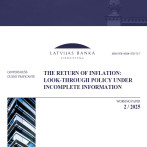Consumer prices in April driven up by supply factors
According to the data of the Central Statistical Bureau, the consumer price level in April was 0.4% higher than in March and 0.8% lower than in April 2015 indicating that year-on-year consumer price changes have remained in the negative range for four consecutive months. The month-on-month rise was primarily the result of changes in fuel prices, which followed the rise in world oil prices, as well as of the seasonal appreciation of wearing apparel, footwear and vegetables. The changes in excise tax on alcoholic beverages had no increasing effect on the average price level in this group.
Oil prices in the global market continued to rise gradually in April, despite the unsuccessful negotiations initiated by OPEC on decreasing production. As was to be expected, the impact of fuel price changes on inflation increased (the prices of fuel rose by 3.2% month-on-month). Meanwhile, the global food prices rose in April for a third consecutive month, according to the data of the Food and Agriculture Organization (FAO), and the downward trend continued only in the prices of dairy products, for in this market, demand lags behind supply. Yet in Latvian retail trade, the prices of dairy products in fact rose in April. Their decrease might be possible in May as indicated by the announcement of the dairy manufacturing company Food Union about cutting the prices of the dairy products of certain brands for the purpose of fostering sales and maintaining the purchases of milk.
Although the changes in the excise tax on alcoholic beverages took effect already in March, this did not translate into higher average price level of this consumer price group in April yet. Just the opposite: in August of last year, the rise in the prices of alcoholic beverages coincided with the changes affecting excise tax. Yet, in contrast to tobacco, consumption of alcoholic beverages and pricing policies are slightly more flexible and therefore there may be no coincidence between the changes in excise tax and those in end-prices. For example, the amount of excise tax is not calculated using the combined rate, i.e., it is not affected by the end consumption price but only by the kind of beverage it is. Also, in this group of goods, discount sales are organized and seasonality may be pronounced, for instance, in the sales of beer.
As already indicated by retail data of the first quarter, in real terms, retail growth is slowing without increasing the demand side pressure on prices. In April, the annual drop in non-food goods prices did not change substantially. Service prices in April rose less than expected and their annual rise contracted. One of the reasons for this was the fact that the substantial contraction in the prices of air transport services and package holidays (they dropped in April by respectively 10.7 and 8.4%). In these groups as well price changes do not signal an increase in the pressure from demand.
The average rise in wages is expected to be slower overall than last year, because the positive impact of legislation on net salary will have contracted. Therefore, the income side will not act as an important engine for inflation and the average annual inflation will remain very low.
Textual error
«… …»






